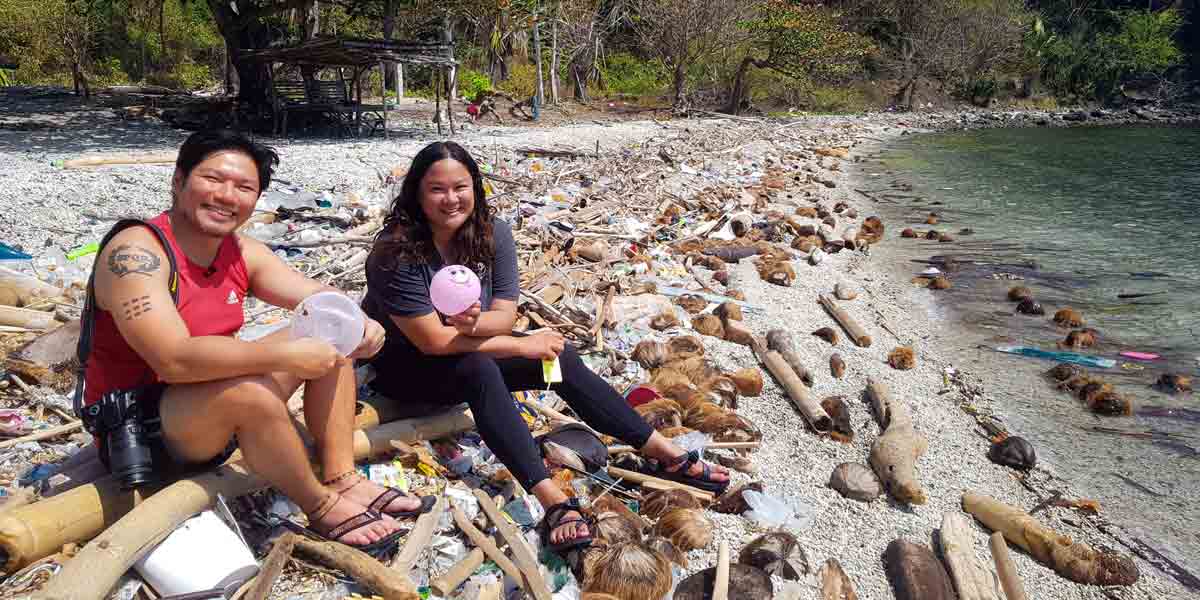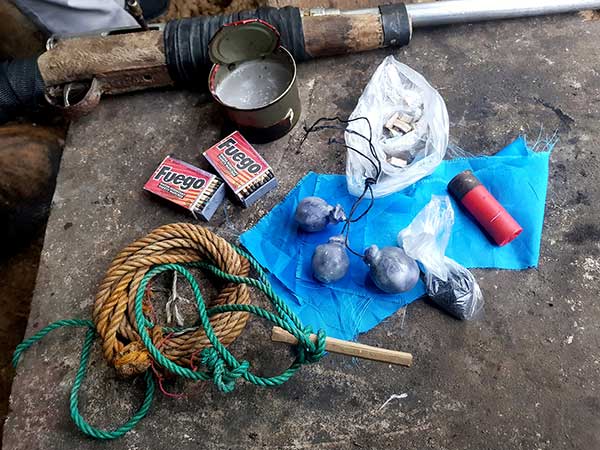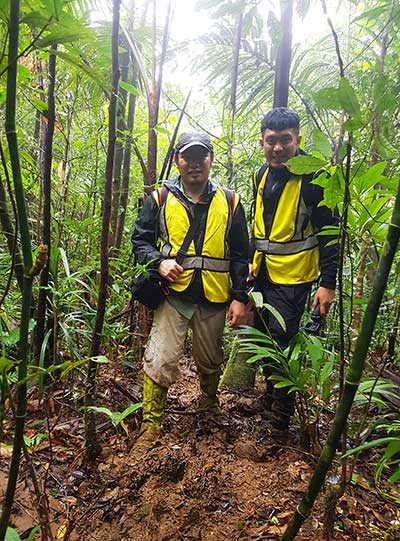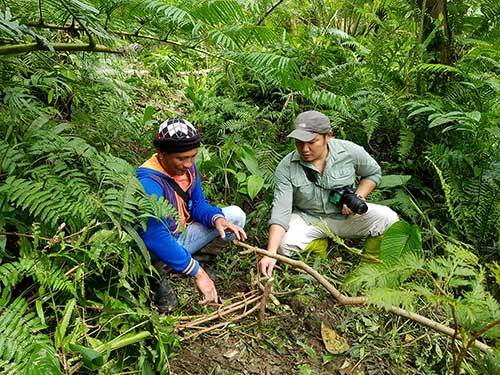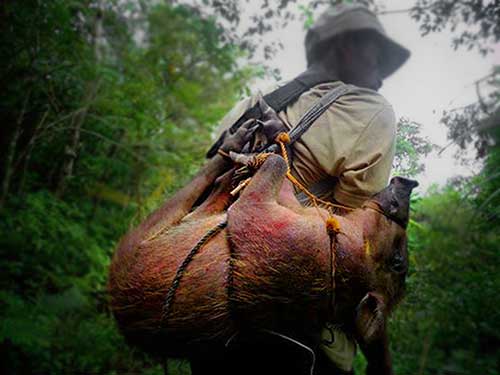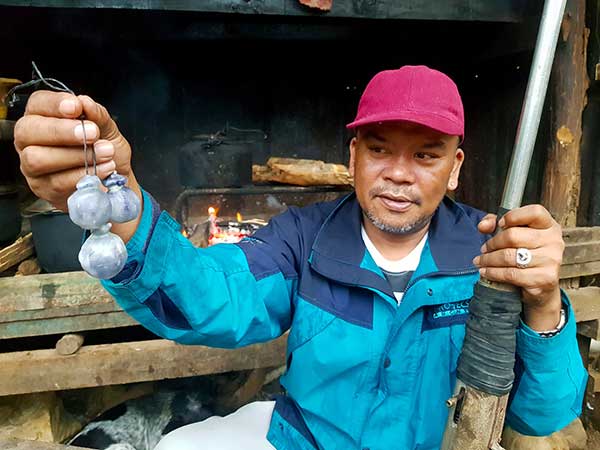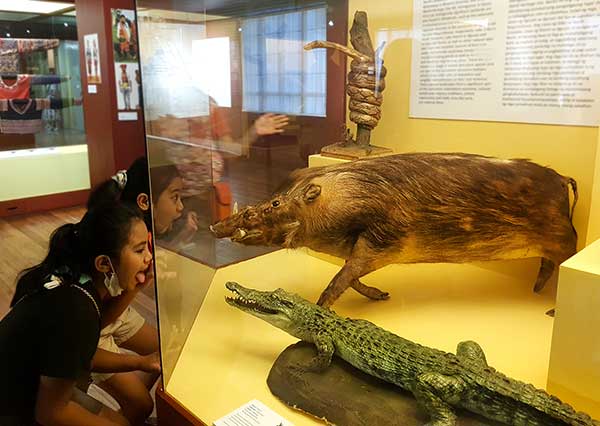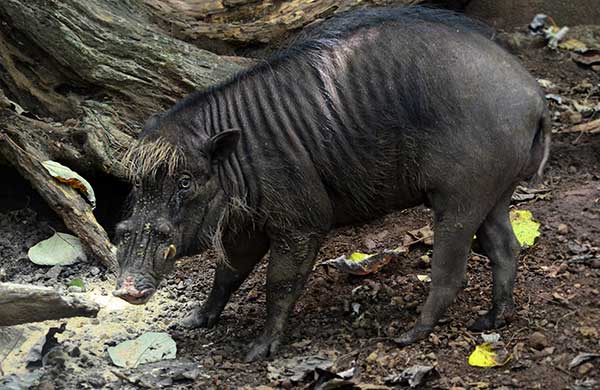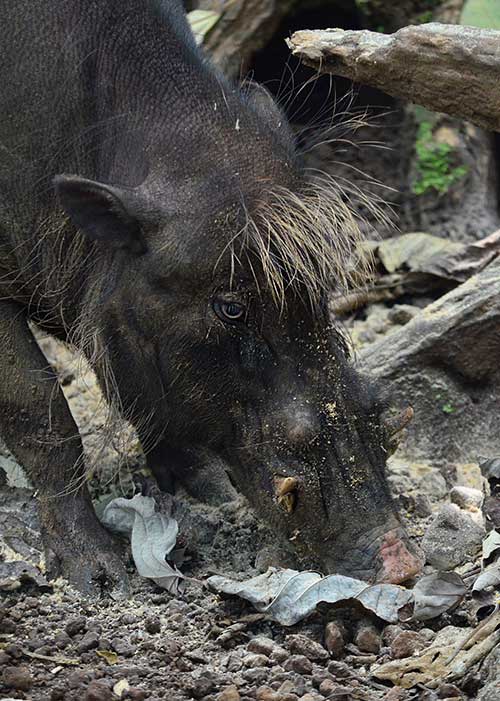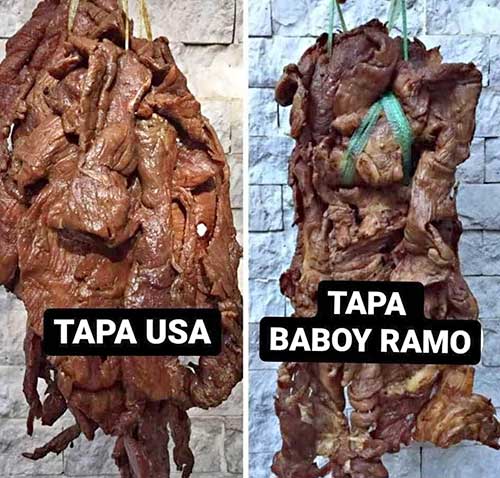By Gregg Yan
“Whenever I had no money to buy food, I used to set snare traps like this,” demonstrates Ed Permangil, who spent 30 years trapping Philippine Warty Pigs in the mountains of Leyte. “When a pig steps on this spring-loaded snare, one of its legs might get entangled. Snared pigs can last up to a week before dying of dehydration. We slaughter, gut and chop pigs up right in the jungle and bring down just the meat.”
I’m in the mountains of Leyte to interview wild pig hunters, poachers and trappers for a documentary. Chewing betel nut, Ed shows me how to disarm a snare. “I once set up to 20 traps daily. I must have caught nearly a thousand wild pigs since the 1990s. Baboy Damo meat has very little fat and sells from PHP350 to PHP700, depending on who you are selling to. It has a gamey, smoky flavor, like rotten wood.”
Ed has since retired as a hunter: in 2019, he was deputized by the Department of Environment and Natural Resources (DENR) as a patrolman of the Barangay Forest Protection Brigade.
‘Ping Pong’ Pig Bombs
The Philippines hosts five wild pig species and they’re all threatened with extinction. The Philippine Warty Pig (Sus philippensis), Oliver’s Warty Pig (S. oliveri), Palawan Bearded Pig (S. ahoenobarbus) and Visayan Warty Pig (S. cebifrons) are endemic and found nowhere else on Earth. The Bearded Pig (S. barbatus) is found in Tawi-Tawi, plus other islands in Indonesia and Malaysia.
The Philippine Warty Pig, Oliver’s Warty Pig and Bearded Pig are classified by the International Union for Conservation of Nature (IUCN) as Vulnerable, the Palawan Bearded Pig as Near Threatened and the Visayan Warty Pig as Critically Endangered.
In the Philippines, wild pig hunters prefer to set passive traps to capture or kill their quarry, as tracking them in the bush – even with hunting dogs – is difficult and dangerous. Injured pigs can be fierce, fighting back with razor-sharp tusks.
“We don’t want to walk around with rifles or homemade firearms, such as my 12-gauge pugakang or makeshift shotgun,” reveals former hunter Iñigo Orias. “The areas wild pigs inhabit are the same areas where rebel cells operate, so we don’t want to be mistaken for combatants. It’s safer to just lay traps and wait.”
Iñigo prefers to hunt pigs with homemade explosives. “This is a type of pig-killing bomb called a pong, because it looks like a ping-pong ball,” he says while showing me three gleaming silver bombs. “This is made from a combination of gunpowder, phosphorous match heads, shrapnel made from broken ceramic tiles and a primer, all dipped in wax for waterproofing. We wrap this in smelly bait – such as the rotting hide of a water buffalo – and tie it off so other foragers like rats and Monitor Lizards can’t drag it away. When a wild pig eventually sniffs and bites the bait, the primer ignites and the pig’s head explodes. If we find the carcass before it rots, we can sell the meat.”
Both Ed and Iñigo know the hunting of wild pigs is illegal.
“Under Republic Act No. 9147 or the Wildlife Resources Conservation and Protection Act, all native wildlife species in the Philippines are legally protected,” explains noted wildlife researcher Emerson Sy. “Our wild pig species have been assessed as threatened, with statuses ranging from Vulnerable to Critically Endangered. A person who is found guilty of killing a threatened species by the court may be imposed a fine of PHP20,000 to PHP1,000,000 and / or one to 12 years in jail.”
An Initiative to Protect Wild Pigs
Though wild pigs are nowhere near as loved or celebrated as the Tamaraw, Philippine Eagle or Tarsier, they quietly do their part to keep our forests alive and productive.
“Wild pigs serve an important ecological purpose as they help regenerate forest habitats through soil aeration and seed dispersion,” said former DENR Wildlife Resources Division Chief Atty. Theresa Tenazas. “We should change the negative connotations associated with Baboy Damo to finally reduce the demand for bush meat.”
The Philippine Warty Pig is just one of nine species under BINHI’s Flagship Species Initiative (FSI), a programme under the country’s largest renewable energy generator, the Energy Development Corporation (EDC). Representing iconic wildlife found in its geothermal, solar and wind sites, FSI aims to popularize some of the nation’s lesser-known forest denizens.
“In EDC, flagship species are not only icons to mainstream Philippine biodiversity conservation. They also serve as indicators of the effectiveness of our forest protection and biodiversity conservation efforts,” explains EDC Watershed Management Officer and FSI Project Leader Abegail Gatdula.
The eight other flagship species include the Giant Golden-crowned Flying Fox (Acerodon jubatus), Visayan Hornbill (Penelopides panini), Apo Myna (Goodfellowia miranda), plus native trees like the Mapilig (Xanthostemon bracteatus), Katmon Bayani (Dillenia megalantha), Red Lauan (Shorea negrosensis), Almaciga (Agathis philippinensis) and Igem-dagat (Podocarpus costalis).
Ed and Iñigo have now transformed from wild pig hunters to protectors – working full-time to prevent trappers, hunters and poachers from denting wild pig populations in Leyte.
“We work closely with local communities so warty pigs will always be protected,” concludes Nelmar Aguilar, EDC’s Watershed Management Officer for Leyte. “Beyond sustainable development, we need regenerative development to maintain the balance of life on Earth.” (ENDS)














